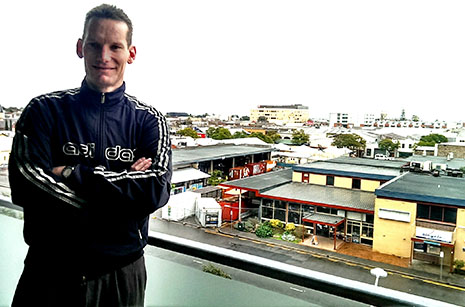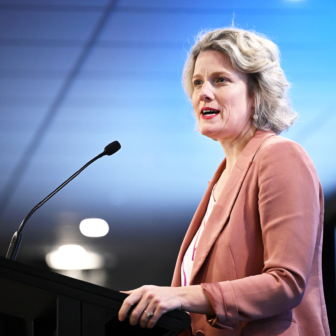THE Palladium, a seventeen-storey residential tower under construction on Adelaide’s Light Square, is being marketed as the city’s “most indulgent address.” Potential residents have been invited to express their interest in acquiring one of the fifty-four “luxurious,” “sophisticated” and “exclusive” apartments.
Just metres away, in the building next door, is a housing project of a very different kind – one that caters to the needs of Adelaide’s most disadvantaged residents. And because that apartment block also looks like an example of chic inner-city living, the well-heeled occupants of the Palladium may never realise that their neighbours live at the other end of the wealth scale.
Four storeys high, with an elegant facade rich in architectural detail, the main building is a former printer’s warehouse that stood empty for years before being converted into housing. With deft use of colour, the architects have integrated this heritage-listed, redbrick block with a slim, contemporary construction of equal height. Together, these two buildings make up Common Ground, a complex of fifty-two “basic but decent” one-bedroom units that provide secure, affordable accommodation for people on low incomes or at risk of homelessness.
The mix of low-income residents and residents at risk of homelessness is deliberate. Half of Common Ground’s tenants are people who would struggle to afford market rents, but whose lives are otherwise relatively stable; the rest are “supported” tenants, who receive intensive assistance from on-site case workers to help them to overcome chronic problems such as substance abuse and mental illness. Supported tenants were previously homeless and many, like Guy Calvert, have spent long periods sleeping rough.
“A year or two ago you might have found me in Whitmore Square with a needle in my arm and drinking metho,” Calvert tells me. “Now I’m living in a nearly brand-new apartment with reverse cycle air-conditioning and a balcony that has an awesome view right down to the beach at Glenelg.”
Aged thirty-five, Calvert has struggled with substance abuse since he was a teenager. “I began drinking and taking escape drugs like Valium and codeine in response to stuff that happened when I was a kid,” he says. “I never learnt how to deal with it.”
From his first experience of homelessness when he was fifteen, Calvert moved in and out of jobs and in and out of houses, alternating for almost twenty years between periods of abstinence and periods of addiction. “I tried to do my best, to stay working, to keep myself on track, but the alcohol and the painkillers would always come first,” he says. “As long as I had cigarettes, Valium, alcohol and a backpack I’d just cruise around. I could medicate myself to deal with things. The thought of waking up sober in the morning absolutely terrified me.”
Calvert says he often wanted “to jump back into society” but did not know where to start. But a start eventually came his way when he met a Common Ground support worker at the Salvation Army. Within six months Calvert was living in one of the apartments on Light Square. He has since moved to Common Ground’s other building in central Adelaide, a complex of thirty-nine units above the Franklin Street bus station.
A year after taking up residency, Calvert is studying for an honours degree in science at Flinders University and paying his way by working night shifts behind the counter at a twenty-four-hour petrol station. He is sober, drug-free and helping others to deal with their addiction through Alcoholics Anonymous.
Common Ground is not just temporary accommodation to get Calvert back on his feet. It is his permanent home. He has a standard tenancy agreement that is periodically renewed as long as he honours the terms of his lease. Rent is pegged at 30 per cent of his income and he pays his own power and water bills. He can live in his flat as long as he chooses.
COMMON Ground is an idea borrowed from the United States after a visit to Adelaide by Rosanne Haggerty under the city’s now-defunct Thinkers in Residence program. Starting in 1990, Haggerty had built an alliance between government, business and philanthropists to convert the run-down “drug den” of New York’s Time Square Hotel into attractive and affordable housing. From the beginning, the idea was to provide secure accommodation to people on low incomes as well as to the homeless, and provide support services to increase the chances that residents would be able to make a success of their tenancy.
Since then, Common Ground has created 3200 units of housing in the northeast of the United States, assisting more than 5000 people to find a secure place to live. In Adelaide, the first Australian city to adopt the model, the Franklin Street project opened in 2008 and Light Square in 2011. Other cities were not far behind. In 2010 Elizabeth Street Common Ground opened with 131 studio apartments in central Melbourne; Common Ground Camperdown in Sydney opened the following year with 104 apartments. Since last year, Common Ground South Brisbane has offered 146 units and, in two separate locations, Common Ground Tasmania offers ninety-seven units. A project is under development in the ACT and South Australia has pioneered the first example of Common Ground housing outside a capital city – thirty-five units in Port Augusta catering primarily to Aboriginal people. While each state-based organisation is autonomous, they promote their activities nationally through the Australian Common Ground Alliance.
Tony Keenan, CEO of Melbourne-based housing provider Hanover Welfare Services, says the Common Ground philosophy is an example of the “housing first” or “home first” approach to homelessness that aims to facilitate immediate entry into permanent accommodation. This reverses the established approach, sometimes described as a “staircase” model, which guides clients through different levels of time-limited temporary housing until they qualify for a permanent residence. The first step is short-term crisis accommodation, which might be an emergency shelter or a hotel room. The second step, generally for a maximum of twelve months, is transitional housing – usually a private rental property, but sometimes a boarding house or an on-site caravan. By the time the year is up, it’s hoped that clients will be ready to live independently and will have made their way to the top of the public housing waiting list or found an affordable rental property.
Keenan says the staircase approach is based on the conventional wisdom that “you need to stabilise people first, before they can cope with housing.” In other words, because homeless people often present with “multiple, complex problems,” it’s imperative to treat addiction or mental health issues before trying to move people into secure tenancies.
“Housing first” takes the opposite view. It is based on a belief that a homeless person’s mental illness or addiction can only be successfully dealt with after his or her housing has been stabilised.
For Keenan, one of the flaws in the established approach to homelessness is that it often fails to remove people from a “homeless subculture.” As a result, many people struggle to overcome problems like substance abuse and easily revert to damaging behaviours.
This accords with Guy Calvert’s personal experience. In his previous attempts to overcome homelessness, he tells me, he was moved into places “where there was a dealer in every second unit and half the residents were on methadone.” There were constant fights and he worried that his flat would be broken into if he went out. “Trying to live a normal lifestyle in one of those places is pretty much impossible,” he says. “It’s like trying to sleep in a battlefield in Afghanistan.”
Calvert says “the whole vibe” at Common Ground is different from anywhere he has been before. His neighbours at Franklin Street include other students and workers and a young mother. Even those who are not employed or studying “at least talk about trying to get a job and not about trying to score,” he adds.
“It’s a little community. Everyone knows each other and tries to help each other out. If someone starts drinking again or is struggling, then everyone knows about it and they will be offered support.” He acknowledges that some residents “are still people having issues,” but says that “they are trying to get their act together, and at Common Ground if you’re running amok or being an idiot then you’ll be assisted to change or asked to move on.”
Sally Langton, executive manager of operations at Common Ground, says it’s essential to keep the balance in the community and make sure the place is working well. “One bad egg and the whole place goes to shit in three weeks,” she says. “I’ve seen it happen.”
In the United States, Common Ground buildings often have a concierge to keep an eye on who goes in and out. There are no on-site guards in Adelaide, though the buildings are fitted with CCTV and the locks on the fire escapes are checked during the night by a security firm.
Langton says the key to maintaining order is a robust complaints process that encourages tenants to take responsibility for what happens in the building and for resolving conflicts. It is one of the many Common Ground policies designed to help residents improve their communication skills and build independence.
“We want to give them the confidence and resources to move beyond a soup kitchen mentality and become functioning citizens,” says Langton. “The message is, you’re not actually homeless any more and you don’t have to behave like a homeless person. You’re an ordinary member of society.”
THE tenant mix at Common Ground is roughly representative of the adult homeless population. About 60 per cent are male and 40 per cent female, and they range in age from eighteen to eighty. Some, like Guy Calvert, have been homeless for much of their life and a few are “second generation” homeless. Between 20 and 30 per cent of residents are Indigenous; the rest come from a variety of backgrounds. Many are Australian-born; others hail from countries as diverse as Pakistan, Syria and Congo.
Common Ground’s small one-bedroom units don’t currently cater for families or couples, though this will change when a third Adelaide property is completed. (Of the fifty-two units planned for the $17 million project, nineteen will be set aside for couples and small families.) Nor does Common Ground offer housing to people aged under eighteen, who are instead referred to services like Ladder St Vincent Street in Port Adelaide, an example of the Youth Foyer movement that offers housing and other support in order to engage homeless and at-risk kids in education. (Foyer served as the inspiration for Rosanne Haggerty’s original Common Ground project in New York.)
More than 300 people are on the waiting list for a place at Common Ground but turnover is slow. On average, about two vacancies come up every month. When people move on, Langton says it is generally for positive reasons. They may have found a partner or a job, or they might want a dog or a car or a spare room and so opt to move out into the private rental market. Others eventually secure public housing. Sometimes an older resident moves into aged care or dies. The community recently farewelled a tenant who passed away from liver disease: he had lived at Common Ground for two years and was able to stay in his apartment for all but the last five days of his life.
Langton acknowledges that Common Ground doesn’t work out for everyone. “Some people are not suited to high-density living,” she says. “Most South Australians don’t live in apartments. We are putting the hardest-to-house in some of the most challenging living environments for Australians. Small spaces, close together, with many shared spaces.”
But she insists that the scheme is more effective than an approach that scatters people around the city without adequate assistance. “There are way too many people living out there alone in the community without any support,” she says. “The only person they have a relationship with is their landlord and that is tragic.”
Langton believes that loneliness and exclusion are among the biggest killers of disadvantaged people. “When homeless people are placed in detached housing out in the community, the resulting social isolation often leads to failure,” she explains. “Loneliness can lead to someone hooking up with the wrong person, or inviting people in that they don’t really want around. Alternatively it can lead to illness. A place like Common Ground doesn’t solve all the ills of loneliness but a close cohesive community can heal people.”
To qualify for a place at Common Ground, potential tenants must be able to pay rent, which means they need an income of some sort. In most cases this takes the form of a government benefit, at least initially, though the aim is to help tenants to study or find a job.
This is not easy. Without formal skills, employment options are limited to mundane casual jobs like cleaning. Sally Langton says many residents only work in fits and starts because of fluctuating emotional or psychological states. “A lot of people have been so battered by life that it’s very hard to hold down a full time job.”
But Guy Calvert is by no means Common Ground’s only success story. One former resident whose life was characterised by violence and drug addiction is now completing her PhD; another is doing his masters. Others are doing traineeships or certificate courses at TAFE. “We go through all the pain with them,” says Langton, “writing essays, learning how to use computers, proofreading.”
THE one-bedroom units at Light Square are compact but light and airy. Each apartment has its own kitchen and bathroom and comes furnished and equipped with a washing machine. As we head back to the ground floor, Langton points to a handbill for a production of A Midsummer Night’s Dream posted inside the lift. One of the residents is in the cast. Common Ground encourages tenants to do things that connect them with the local community and help them to gain a new sense of themselves.
Organised activities include playing soccer in the Big Issue street football team, taking part in the city-to-sea fun run, joining a cooking class, a yoga lesson or a jam session, going to watch an AFL game or a spot of fishing off Semaphore pier. Many events take place in the building’s shared facilities, which include a kitchen, an art room and a lounge area with computers and free internet access. On the ground floor are offices for Common Ground staff, a doctor’s consulting room, and a dentist surgery with clinics run by staff and students from the University of Adelaide Dental School.
In the small rear courtyard residents care for an aviary with a growing population of budgerigars; outside on Light Square they look after the Salad Truck, a large wooden toy that serves as both a play space and a vertical vegetable garden. During my visit a resident is tending to the pots of lettuces and herbs that nestle in neatly ordered racks along the side of the truck. She tells me that passers-by are encouraged to help themselves and take home leafy greens to go with their dinner. Weekend drunks leaving nearby nightclubs have been ripping out whole plants and smashing them on the ground, so a team of Common Ground residents have organised a sort of “Neighbourhood Watch for vegies” with its own Save Our Salad Facebook page.
NO COMMON Ground project would have got off the ground without significant private sector sponsorship. The mining company Santos has committed more than $3 million to Common Ground in Adelaide, IKEA provided furniture for the fit-out, and architects, designers and builders provided free or discounted services. Melbourne’s Elizabeth Street apartment block was built at cost by Grocon and came in almost $10 million under budget. CEO Daniel Grollo says he felt compelled to give something back to Melbourne because the city had been “very kind to our family and company.” Participation has also enriched the business: “Whilst it’s not easy to measure, we have created far more value for our people and organisation than we have contributed, by doing this at cost.”
Tony Keenan says it is a good example of philanthropy as a strategic investment. “Not just good works,” he says, “but good works that can influence government policy by building capacity and demonstrating impact.”
So should Kevin Rudd or whoever replaces him in the Lodge adopt the “housing first” approach as a solution to homelessness in Australia? In the past five years, Common Ground has provided close to 600 one-bedroom apartments in five capital cities – a not inconsiderable achievement. Yet the estimated number of homeless people stands at more than 100,000 and scaling up the Common Ground model would require a significant investment.
As Sally Langton admits, on the surface Common Ground can appear to be “a pretty expensive little exercise.” Apart from the upfront cost of building inner-city apartments, the intensive case management of supported tenants averages out at about $8000 per resident per year.
This might sound like a lot to governments looking for budget savings, especially compared to current spending on crisis accommodation and transitional housing support, which amounts to about $3000 per person per year. But as Langton points out, current spending on homelessness is clearly inadequate and frequently amounts to little more than a bandaid. Statistics show that people being helped are very likely to end up homeless again.
Langton says $8000 per year is a modest outlay compared to the cost of providing care for people with complex needs such as disability and mental health problems (which can exceed $50,000 per year) or the cost of keeping someone in jail (around $100,000 per year). Common Ground calculates that every dollar spent on intensive support under its model brings a fourfold return in savings to the community as people are assisted to stop cycling through short-term accommodation, hospitals, mental health services, courts and prison cells. “The average alcoholic is arrested, incarcerated and involved in accidents,” says Langton. “When people live in a place like Common Ground, they go to GPs instead of emergency departments and they are less likely to end up back in the criminal justice system.” And, says Langton, a sum of $8000 “is quickly repaid once people start working and giving back to the community through the tax system.”
Overall, $8000 seems a small investment to transform a person’s life. The problem is that the financial benefits are not immediately apparent or easy to calculate. While the costs of Common Ground are concentrated in a single project, the potential savings from reducing chronic homelessness will be dispersed across different services and different levels of government.
ONE experienced analyst of housing and homelessness also wonders whether the potential savings have been oversold. Guy Johnson is a housing worker turned senior researcher at RMIT University. As lead author of a critical appraisal of “housing first” approaches, he argues that there is, as yet, insufficient data to back up the argument that the approach produces major cost savings in Australia. Evidence of savings from similar projects in the United States is “patchy,” according to the study.
Johnson and his co-authors acknowledge that compared to established practices, “housing first” projects chalk up “significant achievements” by keeping people in stable accommodation and reducing the numbers who return to homelessness. Less clearcut, they say, is the evidence that “housing first” produces marked improvements in other areas “such as problematic substance use and social exclusion.”
In a separate article, Johnson argues that many aspects of “housing first” are already incorporated into many Australian programs, and that the approach can ignore some of the larger issues of homelessness “such as poverty and a lack of affordable housing.” “Housing first,” he warns, should not be seen as “the ultimate panacea to the problem of homelessness.”
Tony Keenan shares some of Johnson’s caution. Any approach that becomes “evangelical” and advocates “a one size fits all” approach, he says, will end up being a problem. Yet Keenan believes there is mounting evidence that the “housing first” approach produces savings for government as well as better outcomes for individuals. He points to a large-scale, randomised trial in Canada that shows promising preliminary results, and to evaluations of “home first” projects in the United States. Closer to home, Sacred Heart Mission’s Journey to Social Inclusion initiative also offers evidence of the need to link rapid access to permanent housing with tailored support services.
Keenan points out that not all “housing first” approaches follow the Common Ground model of clustering residents in apartment buildings with on-site services. While this is appropriate for people who need high-level support, another option is to settle people in separate houses around the suburbs and to ensure that appropriate services are delivered to the door.
Keenan also highlights the fact that the scheme is not designed to meet the needs of all 100,000 people classified as homeless in Australia. Rather, it should be targeted at people with multiple, complex needs. “They are a small subset of the total number of homeless,” he says, “but they are the group who suffer the most harm.”
Johnson, too, is positive in his overall assessment, concluding that the wide adoption of “housing first” practices, like those used at Common Ground, could “contribute significantly toward breaking the cycle of chronic homelessness” in Australia.
AFTER decades working on housing affordability and homelessness, Sally Langton describes her two-and-a-half years managing operations at Common Ground as “the most heartening and exciting thing I have ever done.” Her experience of emergency housing was “quick fix and flick” – people were despatched to boarding houses, hotels or motels only to turn up again the following week or the following month, once more in crisis.
At Common Ground, she witnesses people changing and watches them grow. “From the point of not being able to look at you,” she says, “to when they stand up in a public forum and talk about their lives.”
Guy Calvert has no doubt that Common Ground offers a different type of housing service. “Every other place I’ve been in, I’ve wanted to get myself out of there as soon as bloody possible,” he says. But he sees no reason to leave Common Ground, unless he starts earning more than $1200 per week and no longer qualifies as low income: “And when I start doing that,” he says with a laugh, “I’ll be happy to move out.” •




